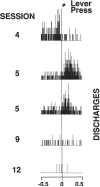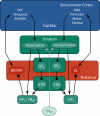Cortical and basal ganglia contributions to habit learning and automaticity
- PMID: 20207189
- PMCID: PMC2862890
- DOI: 10.1016/j.tics.2010.02.001
Cortical and basal ganglia contributions to habit learning and automaticity
Abstract
In the 20th century it was thought that novel behaviors are mediated primarily in cortex and that the development of automaticity is a process of transferring control to subcortical structures. However, evidence supports the view that subcortical structures, such as the striatum, make significant contributions to initial learning. More recently, there has been increasing evidence that neurons in the associative striatum are selectively activated during early learning, whereas those in the sensorimotor striatum are more active after automaticity has developed. At the same time, other recent reports indicate that automatic behaviors are striatum- and dopamine-independent, and might be mediated entirely within cortex. Resolving this apparent conflict should be a major goal of future research.
Copyright 2010 Elsevier Ltd. All rights reserved.
Figures




Similar articles
-
Conditional routing of information to the cortex: a model of the basal ganglia's role in cognitive coordination.Psychol Rev. 2010 Apr;117(2):541-74. doi: 10.1037/a0019077. Psychol Rev. 2010. PMID: 20438237 Free PMC article.
-
A spiking neuron model of the cortico-basal ganglia circuits for goal-directed and habitual action learning.Neural Netw. 2013 May;41:212-24. doi: 10.1016/j.neunet.2012.11.009. Epub 2012 Dec 5. Neural Netw. 2013. PMID: 23266482
-
[Decision-making and learning by cortico-basal ganglia network].Brain Nerve. 2008 Jul;60(7):799-813. Brain Nerve. 2008. PMID: 18646620 Review. Japanese.
-
The Basal Ganglia: More than just a switching device.CNS Neurosci Ther. 2018 Aug;24(8):677-684. doi: 10.1111/cns.12987. Epub 2018 Jun 7. CNS Neurosci Ther. 2018. PMID: 29879292 Free PMC article. Review.
-
A neurobiological theory of automaticity in perceptual categorization.Psychol Rev. 2007 Jul;114(3):632-56. doi: 10.1037/0033-295X.114.3.632. Psychol Rev. 2007. PMID: 17638499
Cited by
-
Neural Mechanisms of Observational Learning: A Neural Working Model.Front Hum Neurosci. 2021 Apr 22;14:609312. doi: 10.3389/fnhum.2020.609312. eCollection 2020. Front Hum Neurosci. 2021. PMID: 33967717 Free PMC article. Review.
-
Structural differences in basal ganglia of elite running versus martial arts athletes: a diffusion tensor imaging study.Exp Brain Res. 2015 Jul;233(7):2239-48. doi: 10.1007/s00221-015-4293-x. Epub 2015 May 1. Exp Brain Res. 2015. PMID: 25929552
-
Exercise-enhanced neuroplasticity targeting motor and cognitive circuitry in Parkinson's disease.Lancet Neurol. 2013 Jul;12(7):716-26. doi: 10.1016/S1474-4422(13)70123-6. Lancet Neurol. 2013. PMID: 23769598 Free PMC article.
-
Declarative Memory Predicts Phonological Processing Abilities in Adulthood.Front Psychol. 2021 May 25;12:658402. doi: 10.3389/fpsyg.2021.658402. eCollection 2021. Front Psychol. 2021. PMID: 34113292 Free PMC article.
-
Current controversies on the role of behavior therapy in Tourette syndrome.Mov Disord. 2013 Aug;28(9):1179-83. doi: 10.1002/mds.25488. Epub 2013 May 16. Mov Disord. 2013. PMID: 23681719 Free PMC article. Review.
References
-
- Rosenbaum, et al. Acquisition of intellectual and perceptual-motor skills. Annu. Rev. Psychol. 2001;52:453–470. - PubMed
-
- Sherrington CS. The integrative action of the nervous system. Yale University Press; 1906.
-
- Lashley KS. Society of Experimental Biology Symposium. Vol. 4. Cambridge University Press; 1950. In search of the engram; pp. 454–480.
-
- Matsuzaka Y, et al. Skill representation in the primary motor cortex after long-term practice. J. Neurophysiol. 2007;97:1819–1832. - PubMed
-
- Moors A, Houwer JD. Automaticity: A theoretical and conceptual analysis. Psychol. Bull. 2006;132:297–326. - PubMed
Publication types
MeSH terms
Grants and funding
LinkOut - more resources
Full Text Sources

